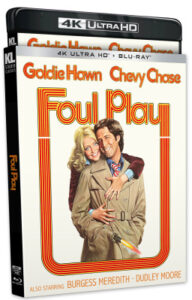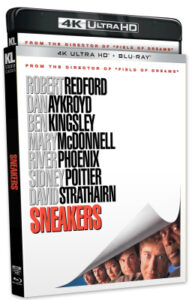April showers in a host of classic and near-classic films to Home Entertainment.
Anora — 4K-UHD — Criterion

With Trump in the White House abusing his executive power at the speed of fascist sound and making unilateral decisions that are helping to make certain the rich bask in wealth and the poor wither and die, it was fascinating to watch Sean Baker’s Anora and get a taste of the good life where expensive champagne flows endlessly, hotel suites have the perks and comforts of mansions and mansions offer extraordinary balconies overlooking the world. Ani, for a brief eventful spell, gets to experience all of that and more. That is, until her husband’s filthy rich, Russian mobster mother puts an end to it all with some pointed threats. Did she really have the power to destroy everything about Anora’s life and the people in it? Why didn’t Ani call her bluff? Fear, most likely. Because even someone as strong as Ani knows when she’s really in danger. And when her Cinderella story has come to an end. And that is when her Prince turns out to be a big ‘ol baby and, to quote Ani, a pussy.
So much has been written about Anora. I’ve mused about it a number of times including my NYFF coverage.
I do want to offer that on a third viewing, via The Criterion’s masterful 4K-UHD, I loved it even more and most of my nitpicky issues vanished. I was gobsmacked that it won five Academy Awards, because it is not an Oscar film by any stretch, hopeful proof that the Academy is, indeed, evolving. Two deserved Best Picture, Director and Actress choices in a row, AMPAS? Never before in my lifetime. Anora is also the first film since Marty in 1955 to win both the Palm d’Or and the Oscar for Best Picture. Oh, and Baker is now a record holder, winning 4 Oscars in 4 different categories in one evening for the same film.
When you dig deeper into Anora and strip away (you can intend the pun) the nudity, profanity and dark comedic elements, you have the simple story of a hopeful young girl who meets a potential Mr. Right, falls in love with him only to discover he has no backbone—and that her possible Mr. Right was there all long, holding her down while she bites him, while he continues to champion her. That oft-told story! But it’s the satiric and decidedly dark—human–elements that make Anora such a significant film. Baker’s ability to both chuckle at and shine a light on societal judgments and attitudes towards sex workers—as well as his biting comment on privilege, class and capitalism, place it in a whole other cinematic league.
Baker and Mikey Madison have also gifted us a heroine for our troubled times, a fighter in control of her own destiny—except when she knows that power could be sucked away—she’s smart enough to admit when it’s time to stop kicking, because she’s also keenly aware that she will survive and, ultimately, thrive. And she will continue to command respect.
Madison has received just global acclaim for the film–as well as that Academy Award–and Oscar nominee Borisov has also been recognized. But Mark Eydelshteyn’s contributions are an essential element to the film’s magic. He’s a true find and it will be interesting to see what this trio of remarkable thesps do next. Watch my vid chat with Eydelshteyn here.
This Criterion 4K-UHD/Blu-ray director-approved special edition is a glorious tribute to the film, shot in splediforous 35mm, and any budding filmmaker should devour it to learn about indie filmmaking.
The special features are a treat beginning with two audio commentaries, both with Baker. The first includes cinematographer extraordinaire Drew Daniels and the film’s producers talking tech. The second has Baker chatting with his actors, Madison, Borisov, Eydelshteyn, Karren Karagulian and Vache Tovmasyan, about their performances and the shoot.
There are bunch of new chats with Baker and Madison (and actor-stripper Lindsey Normington) as well as the Cannes Film Festival press conference where journos, for the most part, actually ask some decent questions. Baker also discusses the Altman inspired opening.
The goodies also include some delicious deleted scenes.
The piece de resistance, especially for film geeks, is a near-60-minute making-of doc on the 40-day shoot that really takes you through the process from rehearsals to filming. Shot by Baker and members of the team, it focuses on many crew members who are never given screen time in features such as this. It’s an eye-opening account of the making of an indie.
Oh, and the film, looks astoundingly good on 4K, with crisp, clear sound. The entire package is amazing.
Criterion has truly outdone itself with Anora, the little movie that, apparently, could…and did.
https://www.criterion.com/films/34891-anora
Jean de Florette/Manon of the Spring — 4K-UHD — Criterion

French helmer, Claude Berri’s monumental double-bill, Jean de Florette/Manon of the Spring must be viewed together for a perfect cinematic experience. These epic films examine how greed, arrogance, power, dumb luck and ineptitude ultimately shatter the lives of the work’s major players.
The films were shot back-to-back and released in August and November 1986, respectively, in the U.S.
Based on the lauded noel by Marcel Pagnol (who made his own versions of the films in 1952) and set in a small early-20th-century village in Provence, France, Jean de Florette follows a well-to-do patriarch César (Yves Montand) and his somewhat dim-witted nephew Ugolin (Daniel Auteuil)—the last living members of the Soubeyran family—who plot to destroy their neighbor so they can take over his land and make even more money selling carnations. The key is a secret spring that is on said land.
César causes the death of the irascible owner but his heir, the titular Jean (Gérard Depardieu), arrives from the big city with his wife Aimée (Élisabeth Depardieu) and small daughter Manon (Ernestine Mazurowna) in tow. Jean is bent on raising rabbits and making that land his own. The town treat them like pariahs. And, unbeknownst to Jean, César and Ugolin have cemented up the spring.
It’s hard not to give away plot in order to write about Manon of the Spring, so I will simply say that tragedy strikes. Certain people feel rightly guilty, other, cold-hearted bastards, do not. And the second film takes place years later with Manon now all grown up (Emmanuelle Béart) and seeking justice.
There are a number of plot twists but nothing like the final revelation which will shock you just as much as it shocks one of the protagonists.
The performances are all superb led by Montand (who had to be cajoled and tricked into accepting the role). Depardieu is at his finest. The amazing Auteuil, in the showiest role, won the César Award for Best Actor and the BAFTA for Best Actor in a Supporting Role. Béart won the César for Supporting Actress. The film was oddly overlooked for any Oscar nominations and considering the sumptuous cinematography by Bruno Nuytten and the sublime score by Jean-Claude Petit, it seems a ghastly oversight. (France selected Betty Blue as their Foreign Language Oscar submission that year.)
Criterion’s Combo Edition is another one for the ages. The new 4K digital restorations, supervised by Nuytten, is absolutely stunning—everything looks simultaneously exquisite and grimy. The 5.0 surround DTS-HD master audio soundtracks are clear and clean.
There are only two major special features but both shed light on Berri. Claude Berri: The Card Dealer is a 2018 documentary on the director’s life and career, which was fairly topsy-turvy. And The Force of Destiny is an excellent 2017 doc about the making of both films. I wanted more, but perhaps that just means seeking out more Berri titles.
This Edition is a must for film lovers.
https://www.criterion.com/boxsets/7935-jean-de-florette-manon-of-the-spring-two-films-by-claude-berri
Foul Play — 4K-UHD/Blu-ray — Kino Lorber

Colin Higgins’ comedic thriller, Foul Play, was the very first VHS tape I ever owned. I also recall seeing it twice at the local movie house as a child and laughing hysterically throughout. So, the film holds a special place in this cinephile’s heart. Watching it again on Kino Lorber’s grainy HDR/Dolby Vision Master, from a 4K scan of the 35mm original camera negative, I was transported to the nostalgia of my boyhood.
There are those who will look at this classic film, which was nominated for seven Golden Globe Awards, and refuse to contextualize. Sure, there are 2025-viewing cringe moments involving a dwarf, a sexist womanizer-wannabe and, of course, the-man-must-save-the day trope. But most of it remains funny and the movie did place a strong female character front and center, allowing her the ability to fight back. Goldie Hawn’s Gloria is no damsel in distress. Okay, she might be in distress, but she has her trusty umbrella, and some mace and brass knuckles provide by her bestie Stella (a marvelous Marilyn Sokol) to help her ward off the villains as well as a too-randy hook-up wannabe.
Gloria is a woman still smarting from a divorce who is told she should start taking chances again, so she picks up a hitchhiker who dies midway through a screening of Appointment with Danger. This starts a wacky, suspenseful sequence of events that puts Gloria’s life in peril as she, with the help of some kooky characters, uncover a dastardly plot to kill the Pope! Along the way are zany antics that pay homage to many a Hitchcock movie including The Man Who Knew Too Much, Dial M For Murder and North by Northwest and the movie even includes a MacGuffin involving a pack of cigarettes.
At the center of this wonderful film is a dizzyingly daffy, kick-ass performance by Goldie Hawn, who I don’t think was ever photographed to look as stunning as she is here. Sure, Gloria doesn’t save the day herself, but she helps. Up until this film Hawn was often cinematic window dressing (The Sugarland Express, Shampoo). Foul Play would directly lead to her second Oscar nomination for the robust title role of Private Benjamin in 1980.
The film is peppered with terrific supporting turns, Burgess Meredith literally kicks Rachel Roberts’ ass in a bizarre but riveting sequence near the films’ denouement. And Dudley Moore plays the human mess known as Stanley Tibbets which would lead to his being cast in Blake Edward’s 10 and then his Oscar-nominated triumph in Steve Gordon’s Arthur, three years later.
Writer-director Higgins, who had penned both Harold and Maude and Silver Streak, wrote the film for Hawn in the mid-‘70s but when she didn’t initially come on board, he rewrote it for a then super popular Farrah Fawcett, bathing in the success of season one of Charlie’s Angels. She declined and the project bounced back to Hawn.
For the male lead, Detective Tony Carlson, both Harrison Ford and Steve Martin were offered the roles but turned it down. Chevy Chase, coming off his incredible success on Saturday Night Live was cast. And watching the film today, he’s easily the weakest link. Firstly, it’s obvious that Higgins allowed him his improv and pratfall moments and most of them fall flat (no pun intended). He doesn’t hurt the film, but it becomes glaring that he’s a comic, not an actor (which would continue to prove true in his subsequent movies).
The film’s lone Oscar nomination was for the Barry Manilow song, “Ready to Take a Chance Again,” composed by Charles Fox (who also did the stirring score) with lyrics by Norman Gimbel.
Foul Play was a box office hit and critical reception in 1978 was mostly positive with the exception of the misogynist herself, New York Times grumbler Janet Maslin, who never met a powerful onscreen leading lady she didn’t try and take down. I can cite many examples from her tearing into Barbra Streisand and Yentl to her attack on Jane Fonda in Agnes of God.
Higgins would go on to direct his best film, 9 to 5 (1980) and one other, The Best Little Whorehouse in Texas (1982). Sadly, he died of an AIDS-related illness at 47 in 1988, taken way too early, like so many other gay artist of the time.
The Kino Lorber Blu-Ray (which comes with the 4K) features a too-short doc, Fair Play: Remembering Colin Higgins, which basically features tidbits by Nicholas Eliopoulos, the director of the doc, Celebrating Laughter: The Life and Films of Colin Higgins.
Both discs also feature a new audio commentary by entertainment journalists Bryan Reesman and Max Evry.
Revisiting beloved comedies from days gone by is fraught with hope and possible disappointment. Some of them prove they’re timeless classics (Peter Bogdanovich’s What’s Up Doc?), some are even more clever and hilarious than you remember (Ted Kotcheff’s Who is Killing the Great Chefs of Europe?—which needs a 4K/Blu-ray treatment pronto!). Foul Play may not date as well as one would like but still prove to be charming, often-hilarious and a fabulous vehicle for one of the screen’s greatest female stars.
https://kinolorber.com/product/foul-play-4kuhd
Sneakers – 4K-UHD/Blu-ray – Kino Lorber

Phil Alden Robinson’s has had quite the curious film career. He wrote the screenplays for both Rhinestone (boo!) and All of Me (yay) in 1984 and then made his directorial debut with the affectionate film, In the Mood (which he co-wrote) in 1987. Two years later, he wrote and directed his masterpiece, Field of Dreams, starring Kevin Costner, which received three Oscar nominations include Best Picture and Best Adapted Screenplay. In 1992, he made the highly ambitious suspense-thriller Sneakers. He would only direct three more movies and write less than a handful of others before creating the brilliant Paramount+ TV series The Good Fight in 2017.
Sneakers, co-written by Walter Parkes and Lawrence Lasker, brought together revered thesps with exciting newcomers to create a super prescient look at the power of information and explore the possibility of cyber warfare. Mind you, this was made 33 years ago, so it was way before it’s time.
Screen icon Robert Redford (Oscar-nominated for The Sting) plays Martin Bishop who leads a team of hackers that include Sidney Poitier, Dan Ackroyd, David Strathairn and River Phoenix. Ben Kingsley, James Earl Jones and Mary McDonnell round out the starry cast.
The gaggle of clever misfits (known as ’sneakers”) are often hired to test security systems, but Bishop’s hidden past is about to bite him on the butt when government agents blackmail him and his team into tracking down some mysterious black box. They soon discover that this box can break into any computer system in the world—meaning potential cyber warfare.
This cast has chem and charisma to boot. Redford rocks his part with the charm we’ve come to expect from the legend. Phoenix is exceptional in one of his final screen roles before his untimely death—a part that could almost be seen as a follow up to his Oscar-nominated turn in Sidney Lumet’s extraordinary Running on Empty in 1988. Kingsley makes a fun villain. And Strathairn steals his scenes in the role of a blind sound man.
I recall enjoying Sneakers when I first saw it, in its initial theatrical run and I felt the same way watching Kino Lorber’s 4K-UHD Special Edition disc. The new HDR/Dolby Vision Master – from a 4K scan of the 35mm original camera negative is a treat for the eyes. Sound quality is top notch.
Two archival audio commentaries are included, one by Robinson, Lasker and Parkes, the other by Robinson and cinematographer John Lindley.
The best treat is a 40-minute doc, from 2003, that dives fairly deep into the making of the film.
Sneakers is a high-tech heist movie that has quite a bit to say about what was going on in the world in 1992 — and what is still going on in the world.
https://kinolorber.com/product/sneakers-4kuhd
Sands of Iwo Jima – 4K-UHD/Blu-ray – Kino Lorber

The Kino Lorber 4K-UHD/Blu-ray combo of Allan Dwan’s Sands of Iwo Jimais the first high-definition version of the film, and it proves to be a terrific, sharp restoration.
I can honestly and shamefully admit that I am a John Wayne fan who has never seen this film—at least never as an adult. (My dad would watch whatever JW film was on TV so growing up I was exposed to a lot of his features!) It was also his only Oscar-nominated performance until he would finally win for Henry Hathaway’s True Grit (1969).
This 1949 film has the Duke playing Sergeant Stryker, a hard-ass Marine whose task is to speedily turn a host of naive boys into combat-ready fighting men—who will be part of the assault against the Japanese army on the island of Iwo Jima during WW2. Stryker doesn’t need to be liked, he needs to be obeyed which puts him in conflict with a few of the recruits, specifically Pete Conway (an excellent John Agar), who sees Stryker as an unfeeling brute.
The film blends striking real footage of the battle with Dwan’s newly shot scenes. That lends the movie a hard authenticity and makes it quite compelling.
Sure, there’s some silly Hollywood dialogue (courtesy of Harry Brown and James Edward Grant, screenwriters) but for the battle scenes alone and the chance to watch Wayne in a role that goes against his usual style, the film is more than worth a look.
Sands was nominated for four Oscars, Wayne, Film Editing, Sound Recording and Writing, Motion Picture Story. A sequel was planned but never made.
The KL disc, via a brand new HDR/Dolby Vision Master – from a 4K scan of the 35mm original camera negative, finalized by Paramount, looks amazing. The sound is also impressive. The 4K also includes new audio commentary by filmmaker/historian Steve Mitchell and Combat Films: American Realism Author Steven Jay Rubin. The main Blu-ray goodie is The Making of Sands of Iwo Jima, hosted by Leonard Maltin, a surprisingly insightful doc.
For war movie aficionados, Oscar historians and John Wayne fans, this one is a keeper.
https://kinolorber.com/product/sands-of-iwo-jima-4kuhd
Donovan’s Reef – 4K-UHD – Kino Lorber

The reasons to pick up Donovan’s Reef, have everything to do with the cast, locations and score.
The 1963 picture marked the final collaboration between John Wayne and 6-time-Oscar-winning filmmker John Ford, that formidably began withStagecoach in 1939 and included classics such as She Wore a Yellow Ribbon(1949), The Quiet Man (1952), The Searchers (1956) and The Man Who Shot Liberty Valence (1962). All total; they made 14 movies together. This one is, arguably, the silliest, but it doesn’t make it any less entertaining and worthwhile.
It’s the 1960s in French Polynesia and Michael Donovan (Wayne) runs the titular saloon and a lives fairly content life. But on a shared birthday once a year Donovan’s old Navy bud, ex-pat Thomas Gilhooley (Lee Marvin, doing a hilarious prelude to his Oscar-winning Cat Ballou drunkard) arrives to challenge Donovan to a fistfight. They’ve been at it for 21 years. This has little to do with the plot but takes up a lot of screen time.
Another Navy pal, Doc Dedham (Jack Warden) also lives on the island. Meanwhile, Doc’s estranged daughter Amelia has arrived from Boston to look into her father’s life regarding an inheritance issue. Donovan and his clan devise a plan to hide Doc’s half-breed children to protect him, while he is off helping others. Amelia and Donovan initially clash but soon fall for each other.
There’s a lot of plot in Donovan’s Reef and it’s definitely a genre-blend, often funny, sometimes poignant with action scenes to keep Wayne fans happy.
Elizabeth Allen had a four-decade career on stage, screen and TV but only made six feature films, including John Ford’s Cheyenne Autumn in 1964. She was nominated for two Tony Awards for the Broadway musicals, The Gay Lifein 1962 and Do I Hear a Waltz? in 1965. On TV she starred in Bracken’s World, The Paul Lynde Show, C.P.O. Sharkey and the soap, Another World. I’m not sure why she wasn’t cast in more leading movie roles because she shows every sign of being a bona-fide leading lady here.
Wayne delivers a sweet, understated turn.
Cesar Romero and the fab Dorothy Lamour also appear in smallish roles.
William H. Clothier’s lush cinematography captures the vistas magnificently—the movie was actually shot in Hawaii. And I cannot rave enough about Cyril Mockridge’s terrific score. This was the last film he would work on. After four decades scoring over 90 films, he would retire to Hawaii because of Donovan’s Reef. There’s a Hawaiian-blend song, in particular, which dominates the soundtrack, that is infectious (arrangement is uncredited).
This is a brand new HDR/Dolby Vision Master from a 4K Scan of the 35mm original camera negative and the picture quality reflects that—it’s pretty remarkable. And the DTS-HD Master dual-mono track sound is top notch.
Special Features include two new audio commentaries, one by Searching for John Ford author, Joseph McBride as well as one by Lee Marvin: Point Blank author Dwayne Epstein. The Blu-ray includes The Growler Story a 1957 John Ford short.
I truly enjoyed this film and found myself downloading that Mockridge Hawaiian song and listening to it over and over again! Plus, any John Ford film is worth a visit…or two.









